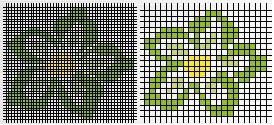Brilliant images in HD
HDTV stands for "High Definition Television". This term includes a tv-standard, the 16:9-movie format, with an unknown color brightness, depth- and sound quality.
What makes HDTV so special, is the high resolution of the TV images. Instead of the usual 768 x 576 pixels, HDTV exists of 1920 x 1080 pixels and offers 5 times more image information as an image in conventional tv. This assures an unknown brightness en sharpness of the image and shows unique details. Next to that the color resolution of HDTV is considerably higher then the one from standard tv (SDTV).
With Dolby Digital you experience a complete new tv experience. With a HDTV digital receiver you have a new world standard in house, which exceeds the current conventional tv images by far.
| HDTV versus SDTV | HDTV resolution versus SDTV resolution | |
 |
 |
What's necessary to receive HDTV?
- A HD-ready tv or a HD television
- A HD-decoder (settop box)
To receive HDTV, you need a digital receiver suitable for HD and a television which is HD / HD-ready. And the program needs to be broadcasted in HD quality.
Future = UHDTV
The sucessor of HDTV, UHDTV, is already available. This is based on a resolution of 7.680 × 4.320 pixels. This new standard is 4x as high and depth as HDTV (max 1920 × 1080 pixels), so the resolution is 16 times as high.











